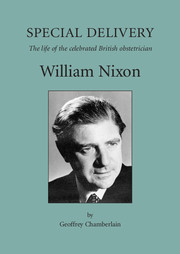Book contents
- Frontmatter
- Contents
- Foreword
- Preface
- Introduction
- Acknowledgements
- Chapter One Early Days (1903–1918)
- Chapter Two The Medical Student (1922–1927)
- Chapter Three Postgraduate Training (1927–1934)
- Chapter Four Consultancies: at Home and Away (1935–1939)
- Chapter Five The War Years (1939–1945)
- Chapter Six The Obstetric Unit in Nixon's Time (1946–1966)
- Chapter Seven Research in the Obstetric Unit (1946–1956)
- Chapter Eight Teaching at UCH (1946–1966)
- Chapter Nine Nixon the Man (1928–1965)
- Chapter Ten Last Days
- APPENDICES
- SOURCES
- INDEX
Chapter Six - The Obstetric Unit in Nixon's Time (1946–1966)
Published online by Cambridge University Press: 05 February 2014
- Frontmatter
- Contents
- Foreword
- Preface
- Introduction
- Acknowledgements
- Chapter One Early Days (1903–1918)
- Chapter Two The Medical Student (1922–1927)
- Chapter Three Postgraduate Training (1927–1934)
- Chapter Four Consultancies: at Home and Away (1935–1939)
- Chapter Five The War Years (1939–1945)
- Chapter Six The Obstetric Unit in Nixon's Time (1946–1966)
- Chapter Seven Research in the Obstetric Unit (1946–1956)
- Chapter Eight Teaching at UCH (1946–1966)
- Chapter Nine Nixon the Man (1928–1965)
- Chapter Ten Last Days
- APPENDICES
- SOURCES
- INDEX
Summary
We and the labouring world are passing by:
Amid men's souls, that waver and give place
Like the pale waters in their wintery race.
Rose of the World (1892) WB YeatsWhen William Nixon joined University College Hospital as Professor in Obstetrics and Gynaecology, he took over from Professor FJ Browne, the first incumbent at that academic unit. Just after the First World War, the Rockefeller Foundation had made a bequest to UCH with the aim of establishing units that would help the development of medical education. Medical and surgical units were started in 1920, with funds provided for teaching on a scientific basis. The department of obstetrics had to await the building of the new Obstetrical Hospital next to the UCH site and so it was not until 1926 that FJ Browne was appointed a Professor of Obstetric Medicine. He took up his first duty of reorganising and improving of the teaching of obstetrics and gynaecology by strengthening his current staff to provide for this.
Browne held antenatal and postnatal clinics in the hospital, which he and his staff attended with the first aim of teaching medical students. Gynaecological patients were shared for teaching purposes between the members of the academic unit and the honorary staff, of which there was only one consultant at this time – Clifford White. With the completion of the new Obstetric Hospital, the number of women attending for delivery increased rapidly. By 1929, one-third of the women having babies in the Borough of St.
- Type
- Chapter
- Information
- Special DeliveryThe Life of the Celebrated British Obstetrician, William Nixon, pp. 50 - 69Publisher: Cambridge University PressPrint publication year: 2004

